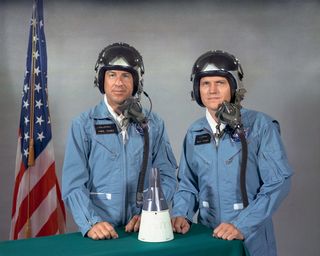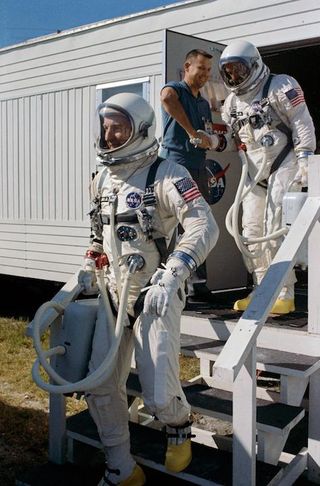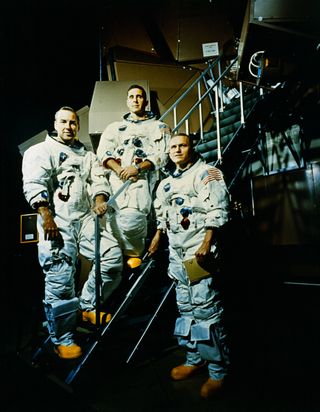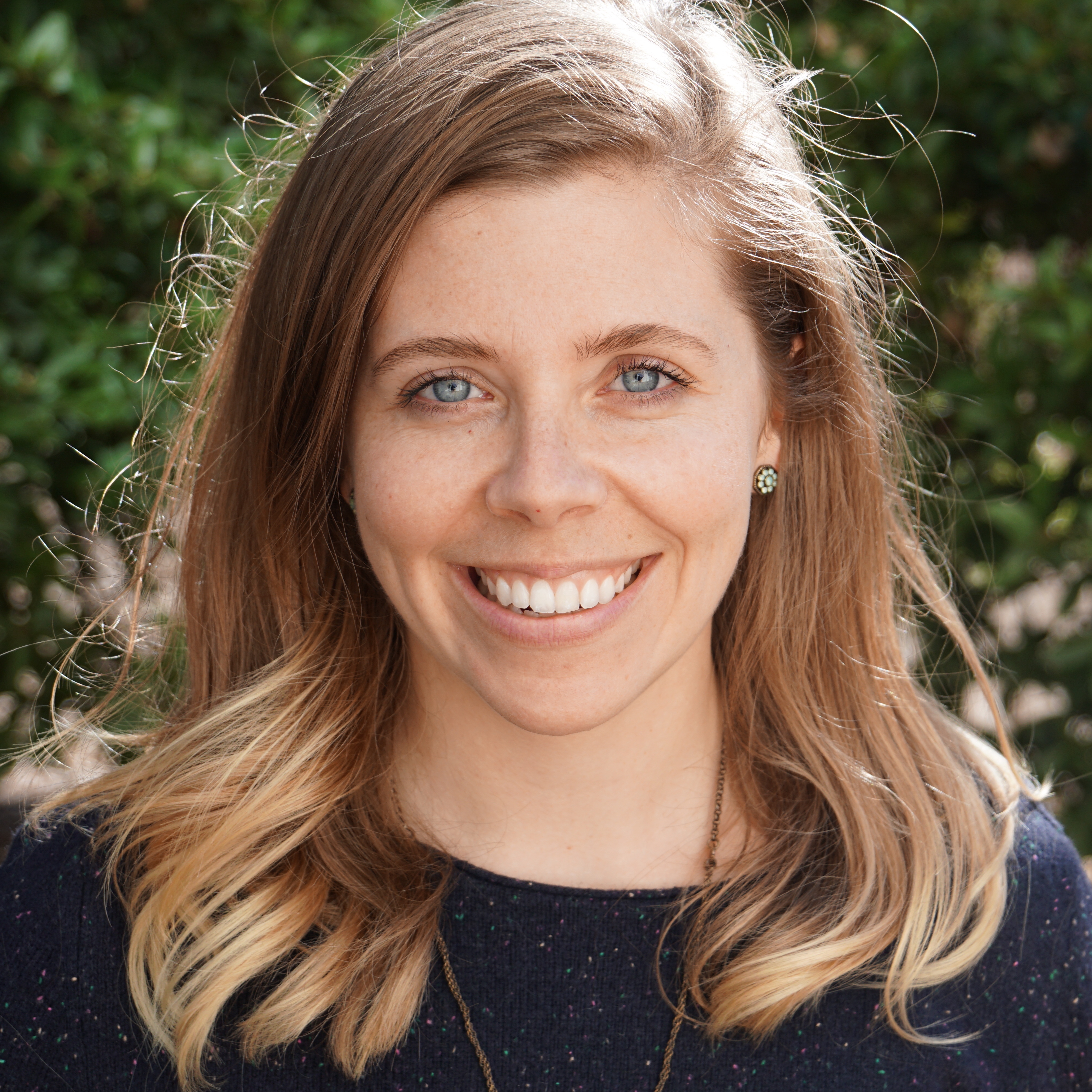Jim Lovell: NASA astronaut and Apollo 13 commander

Jim Lovell is an ex-NASA astronaut who flew with the Gemini and Apollo missions. He's most famous for his role as commander of the ill-fated Apollo 13 mission that so nearly ended in tragedy. At the time of the mission, Lovell had spent more time in space than anyone in the world, and in total, logged over 700 hours in space.
In 1994, Lovell worked with journalist Jeffrey Kluger to write a book about Lovell's career and the Apollo 13 mission. The book, "Lost Moon: The Perilous Voyage of Apollo 13" (Houghton Mifflin, 1994), spurred the 1995 movie "Apollo 13," starring actor Tom Hanks.
From aviator to astronaut
Lovell was born in Cleveland, Ohio in 1928. He developed an interest in rocket science as a high school student, and went on to study engineering at the University of Wisconsin, according to The National Aviation Hall of Fame (which he was inducted into in 1998). Lovell then attended the U.S. Naval Academy where he graduated with a bachelor of science degree in 1952.
In 1958, Lovell graduated from the Navy's test pilot school and spent the next several years testing fighter aircraft and other jets before they were authorized for use by less experienced pilots. The Navy's test pilots were among the best aviators in the country, and as such, were prime candidates for NASA's astronaut program in the early 1960s.
Related: Building Project Mercury: Test flight photos of NASA's first spaceship
Lovell was selected as a potential astronaut candidate for Project Mercury but was turned down because of a temporary excess of a protein called bilirubin in his blood, which could have been indicative of a liver problem. When he protested NASA the response he received was, "I have five men out there who don't have a bilirubin problem, and 26 more on the way who probably don't," Lovell recounted in "Lost Moon."
But he got a second chance when NASA began recruiting astronauts for the Gemini and Apollo programs, and Lovell was selected for the program in 1962.

Endurance and moon missions
Lovell served as a backup for Gemini 4, before being assigned as one of two crew members on Gemini 7, which launched on Dec. 4, 1965.
The Gemini 7 flight was an endurance mission in every sense of the word. Lovell and Frank Borman spent more than 330 hours (nearly two weeks) in a spacecraft about the size of a coat closet. The men carried out nearly 20 experiments and operated without their spacesuits on for the first time, according to NASA. They also successfully rendezvoused with Gemini 6A on Dec. 15, 1965 and the two spacecraft moved around in close proximity for a little over 5 hours. After 209 orbits around Earth, Gemini 7 returned home on Dec. 18, 1965.

Lovell's next trip to space was as commander of Gemini 12, the last flight of Project Gemini. Lovell was accompanied by astronaut Buzz Aldrin, who completed three extravehicular activity operations during the mission. The two-man crew also successfully docked with the Agena target vehicle and performed several experiments, according to NASA.
Related: Apollo 8: NASA's first crewed trip around the moon in pictures
The next step for Lovell was the moon. Apollo 8 launched from Cape Canaveral, Florida on Dec. 21, 1968, with Borman as the commander, William Anders as the lunar module pilot and Lovell as the command module pilot. The mission completed its goal of going around the moon and back, according to NASA. It was the first time any human had journeyed so far, and the men were the first to see the far side of the moon.
"On Apollo 8, we were on the dark side of the moon, which was 60 miles [97 kilometers] below us," Lovell told Chicago Magazine in a 2019 interview. "As we kept on going around, we suddenly saw the Earth coming into view 240,000 miles [386,000 km] away. I could put my thumb up to the window and everything I ever knew was behind it. Billions of people. Oceans. Mountains. Deserts."
Related: Apollo 8 astronaut Jim Lovell looks back on a historic flight around the moon
Lovell's crewmates each wrote farewell letters to their wives before the mission, just in case something happened and they didn't make it back home. But Lovell didn't write a letter, he told Chicago Magazine. "Instead, I went to Neiman Marcus and bought my wife a mink jacket. I had it delivered on Christmas Day with a note that said, 'To Marilyn: Merry Christmas from the man on the moon.'"
The crew made six telecast appearances during their trip around the moon. Millions of people watched the astronauts deliver a Christmas address from space, in which they read passages from the Bible and described the view of space and Earth, unfurling beneath them. Apollo 8 returned to Earth on Dec. 27, 1968.

Apollo 13
Lovell's last mission was as commander of Apollo 13 in April 1970. He was joined by lunar module pilot Fred Haise, and command module pilot John "Jack" Swigert. Swigert was initially Apollo 13's backup command module pilot, but was asked to join the crew 48 hours before launch time after the original command module pilot, Ken Mattingly, was exposed to German measles.
Apollo 13 was the third targeted moon landing. All appeared normal until the evening of April 13, when the astronauts were just a day away from landing on the moon. A stray spark ignited an oxygen tank within the command module, heavily damaging the spacecraft.
Related: This stunning 4K video re-creates Apollo 13's perilous trip around the moon
The three men huddled in the undamaged lunar module — a spacecraft designed for two men to land on the moon — for most of the next four days. To save energy, only the most essential systems were kept powered up. The men were cold, uncomfortable and dealing with a constant barrage of minor issues. But with the help of Mission Control, they arrived safely back on Earth on April 17, 1970.
Life after NASA
Lovell retired from NASA and the Navy in 1973. He went to work for Bay-Houston Towing Company and became the President and CEO in 1975. He later held executive and board member positions for various other companies before retiring in 1991.
Lovell has received many awards and honors including the Collier, Harmon (three times) and Goddard trophies, the Presidential Medal of Freedom, NASA Distinguished Service Medal and most recently, the Congressional Space Medal of Honor, according to The National Aviation Hall of Fame.
Related: 'I hope they take a camera': Astronaut Jim Lovell talks SpaceX moon mission
In 1999, the Lovell family opened a restaurant in Lake Forest, Illinois called "Lovells of Lake Forest," which featured memorabilia from Lovell's time as an astronaut and the Apollo 13 movie. The restaurant saw success for many years but closed permanently in 2015.
Now, at age 92, Lovell graciously provides interviews and participates in space outreach programs when he can.
The 50th anniversary of Apollo 13 is April 11, 2020. Keep checking in with Space.com for updates about Apollo 13 events and celebrations around the world.
Additional resources:
- Read a recent interview with Lovell in which he recounts his experience with Apollo 13, from Astronomy.com.
- Learn more about Lovell's career as an astronaut on this NASA page dedicated to him.
- Check out hundreds of incredible images of the Apollo 13 mission in NASA's photo library.
Join our Space Forums to keep talking space on the latest missions, night sky and more! And if you have a news tip, correction or comment, let us know at: community@space.com.
Get the Space.com Newsletter
Breaking space news, the latest updates on rocket launches, skywatching events and more!

Kimberly Hickock has a bachelor's degree in marine biology from Texas A&M University, a master's degree in biology from Southeastern Louisiana University and a graduate certificate in science communication from the University of California, Santa Cruz. She is a former reference editor for Live Science and Space.com. Her work has appeared in Inside Science, News from Science, the San Jose Mercury and others. Her favorite stories include those about animals and obscurities. A Texas native, Kim now lives in a California redwood forest.
